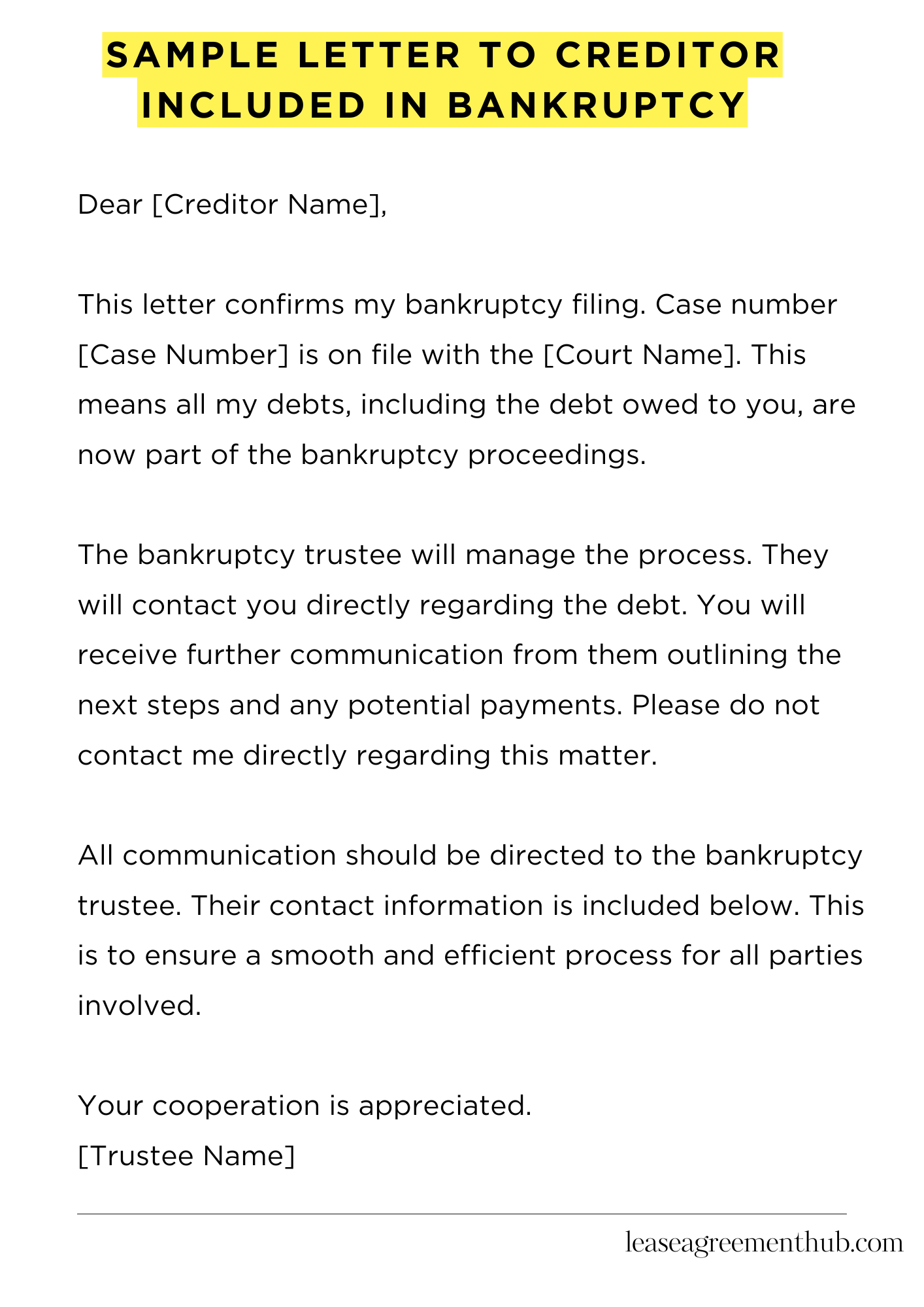A sample letter to a creditor included in bankruptcy is a template or example that individuals can use when communicating with creditors during the bankruptcy process. Its purpose is to provide a clear and professional way to notify creditors of your bankruptcy filing. This helps ensure that all parties are aware of the situation and can adjust their actions accordingly.
In this article, we will share several templates and examples of letters that can be used when reaching out to creditors. These samples are designed to make the writing process easier for individuals facing bankruptcy. By using these templates, you can save time and reduce stress while ensuring that your communication is effective.
Whether you need to inform a creditor about your bankruptcy or respond to inquiries, we have you covered. Each sample letter is tailored to specific situations, allowing you to customize it to fit your needs. With these examples, you’ll find it simpler to navigate your communication with creditors during this challenging time.
Sample Letter to Creditor Included in Bankruptcy
[Your Name]
[Your Address]
[Your Phone Number]
[Your Email Address]
[Date]
[Creditor Name]
[Creditor Address]
Dear [Creditor Name],
This letter confirms my bankruptcy filing. Case number [Case Number] is on file with the [Court Name]. This means all my debts, including the debt owed to you, are now part of the bankruptcy proceedings.
The bankruptcy trustee will manage the process. They will contact you directly regarding the debt. You will receive further communication from them outlining the next steps and any potential payments. Please do not contact me directly regarding this matter.
All communication should be directed to the bankruptcy trustee. Their contact information is included below. This is to ensure a smooth and efficient process for all parties involved. Your cooperation is appreciated.
[Trustee Name]

How to Write a Sample Letter to Creditor Included in Bankruptcy
Understanding the Nuances of Bankruptcy Correspondence
Bankruptcy necessitates precise communication. A poorly worded letter can jeopardize your discharge. Clarity and conciseness are paramount. Ambiguity is your enemy; strive for perspicuity in every sentence. This isn’t just a letter; it’s a legal document that requires careful consideration.
Crafting the Salutation: Respect and Formality
Begin with a formal salutation. Avoid informality. Address the creditor by their formal title and name, if known. For instance, “Dear Mr./Ms./Mx. [Creditor’s Name],” is appropriate. This demonstrates respect and professionalism, vital in establishing a cooperative tone. Incorrect salutation can immediately sour the interaction.
Articulating Your Situation with Precision
Clearly state that you’ve filed for bankruptcy. Specify the chapter (Chapter 7, Chapter 13, etc.). Include your case number for facile identification. This expedites the process by enabling the creditor to immediately locate your file. Avoid obfuscation; directness is key.
Detailing the Debt and Acknowledging its Legitimacy
Identify the specific debt owed to the creditor. Include the account number and the amount owed. Acknowledgment of the debt, even within the context of bankruptcy, demonstrates good faith. This seemingly minor detail can profoundly influence the creditor’s response.
Incorporating the Bankruptcy Court’s Role
Explicitly state that the debt is now under the aegis of the bankruptcy court. Refer to the relevant bankruptcy statutes and rules if necessary. Mention any specific instructions or deadlines imposed by the court. This emphasizes the legal framework governing the situation. Remember, your actions are governed by law.
The Importance of Maintaining a Professional Tone
Maintain a respectful and professional tone throughout the entire letter. Avoid accusatory or belligerent language. Remember, your goal is cooperation, not conflict. A conciliatory approach is far more efficacious. Avoid emotional language, keep it fact-based.
Concluding with a Formal Closing and Contact Information
Conclude with a formal closing, such as “Sincerely,” or “Respectfully,” followed by your typed name, address, phone number, and email address. This completes the communication loop, allowing the creditor to easily contact you if required. Leaving this information is essential.
FAQs about sample letter to creditor included in bankruptcy
What is the purpose of a letter to creditors in a bankruptcy filing?
The purpose of a letter to creditors in a bankruptcy filing is to formally notify creditors of the bankruptcy and provide them with essential information, such as the type of bankruptcy filed (Chapter 7, Chapter 13, etc.), the date of filing, and contact information for the debtor’s attorney (if applicable).
What information should be included in a letter to creditors?
A letter to creditors should include the debtor’s name and address, the bankruptcy case number, the type of bankruptcy filed, the date of filing, contact information for the debtor’s attorney (if applicable), and a brief explanation of the bankruptcy process. It may also include information about the debtor’s intent to communicate further regarding the bankruptcy proceedings.
Is it necessary to send a letter to every creditor?
While not always legally mandated, sending a letter to creditors is generally considered best practice. It ensures all creditors are aware of the bankruptcy filing and helps avoid potential misunderstandings or further communication issues. The bankruptcy court will usually require a list of creditors, but a letter is often considered a courteous and efficient way to inform them directly.
What tone should the letter to creditors adopt?
The tone of the letter should be formal, respectful, and concise. Avoid emotional language or making promises that cannot be kept. The focus should be on providing clear and factual information about the bankruptcy.
Can I use a sample letter as a template?
Using a sample letter as a template can be helpful in structuring your letter and ensuring you include all necessary information. However, it’s crucial to customize the sample letter with your specific details to ensure accuracy and avoid potential legal complications. Always consult with a legal professional for advice on bankruptcy matters.
Related: